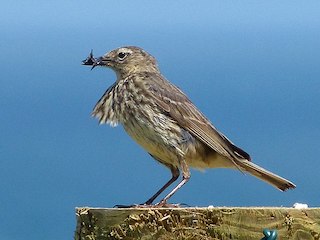 This olive-brown bird is well-camouflaged on the stony beaches it calls home, but watch out for it perching on rocks or feeding along the tidewrack.
This olive-brown bird is well-camouflaged on the stony beaches it calls home, but watch out for it perching on rocks or feeding along the tidewrack.
Photo: MPF / CC BY-SA
Scientific name: Anthus petrosus
Other common names: Eurasian Rock Pipit, Tangle Sparrow
Conservation status: IUCN, Least Concern; the subspecies Anthus petrosus petrosus (the subspecies we see in Cornwall) is Amber in the UK, as it is designated as being an important population.
What to look for:
- Colouring: Olive-grey coloured back and head, buff-coloured beneath with dark streaks.
- Size: A little smaller than a starling.
- Where: Find it round the coast on rocky beaches.
- Song: Listen to its cheeping flight call.
- Similar species: Can be confused with Meadow Pipit (Anthus pratensis), but is distinguished by its darker colouring, dark legs and larger size.
 Many birds visit rocky beaches, but only a few choose to actually live and breed there: the Rock Pipit is one of these. It might be a less spectacular looking bird than other visitors to the shoreline, but it is remarkably well-adapted to its coastal home. Watch out for this olive-brown bird hopping between rocks as it searches for its food of invertebrates and molluscs exposed along the tidewrack by the changing tides.
Many birds visit rocky beaches, but only a few choose to actually live and breed there: the Rock Pipit is one of these. It might be a less spectacular looking bird than other visitors to the shoreline, but it is remarkably well-adapted to its coastal home. Watch out for this olive-brown bird hopping between rocks as it searches for its food of invertebrates and molluscs exposed along the tidewrack by the changing tides.
The Rock Pipit is a uniquely European breeding bird, with up to 300,000 pairs, of which some 34,000 are found on Britain’s rocky shorelines (source: BTO). During the breeding season the male performs a display flight in which he flies slowly upwards, delivering a trill-like song, and then ‘parachutes’ down in a twisting flight path while holding his wings still. The females lay 4 to 5 eggs in May in a mossy nest grass-lined nest in a rock cleft. A pair may raise two broods in a year.
Did you know…?
…There are three sub-species of Rock Pipit, two of which occur in the British Isles. It is Anthus petrosus petrosus that we find in Cornwall and most of the mainland, but in Shetland, Orkney, Fair Isle and St Kilda the subspecies Anthus petrosus kleinschmidti is native.
…Just ‘like it says on the tin’: the species name petrosus is from the Greek word petros, meaning rock.
More information and references:
Gooders, J. and Harris, A., 1986. Field Guide to the Birds of Britain and Ireland. Kingfisher Books, London.
Published: March 2014
Author: Amanda Scott
Photos: MPF / CC BY-SA
